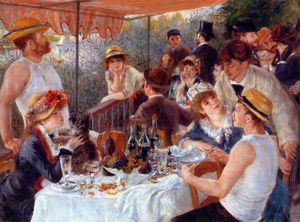Luncheon of the Boating Party Analysis
- Date of Creation:
- 1881
- Alternative Names:
- Le dejeuner des canotiers
- Height (cm):
- 130.20
- Length (cm):
- 175.60
- Medium:
- Oil
- Support:
- Canvas
- Subject:
- Scenery
- Framed:
- Yes
- Art Movement:
- Impressionism
- Created by:
- Current Location:
- Washington, District of Columbia
- Displayed at:
- Phillips Collection
- Owner:
- Phillips Collection
- Luncheon of the Boating Party Analysis Page's Content
- Composition
- Use of color
- Use of Light
- Mood, Tone and Emotion
Luncheon of the Boating Party Composition
The arrangement of Luncheon of the Boating Party represents a relatively new Impressionist movement as well as the changing character of French society due to the industrial revolution. Renoir craftily uses shape, space, color and texture to create the scene he imagined. The figures and bottles add shape to the canvas and the overlapping of bodies gives a sense of space.
Renoir also makes his composition more effective by adopting elements of design such as balance, repetition and harmony. A sense of movement is realized through the actions and expression of the cast and repetition is achieved through the curves of the gazebo cover, the stripes, the posts in the railing and the yellow straw hats which guide the viewers eye around the canvas.
The artists combination of thickly applied brushstrokes and more delicate ones adds to the composition, and specks of red and white make the painting easy on the eye.
In terms of balance, Renoir is extremely clever and succeeds in balancing two figures on the left with twelve on the right. By tilting the floorboards, the artist allows characters in the upper-right background to be easily visible and this adds to the feeling of intimacy and informality.
There is no evidence suggesting that Renoir created any preparatory drawings for Luncheon of the Boating Party or that he made any preliminary sketches on the canvas. Instead he developed his compositions as he went along, a common Impressionist approach.
To organize this arrangement its believed that Renoir gathered most of his subjects at the Maison Fournaise early on. He made several compositional changes when painting the piece, one of the major additions being the striped awning which works to further enforce the feeling of intimacy. Furthermore, the greenery emphasizes the somewhat cozy atmosphere.
Luncheon of the Boating Party Use of color
The colors adopted by Renoir are very rich and he contrasts the deep blue and green with vivid red and greens. Brimming with color this painting reflects both the time period and Impressionist style.
Texture is represented by the figures´ clothing as well as Renoir´s applied brushstrokes. Renoir´s palette also contains many golden tones and the women´s fair skin is reddened from the sun and the hats and bare arms are further evidence of a warm day. Techniques of blending and layering to convey warmth and glowing skin with subtle tints of blue and green are fairly traditional.
Luncheon of the Boating Party Use of Light
There is a great deal of light throughout the composition of Luncheon of the Boating Party. The main light source is the opening in the balcony and the beaming sunlight is reflected by the table cloth and the vests of the two men in the foreground. This canvas captures the momentary effects of changing light and color.
Luncheon of the Boating Party Mood, Tone and Emotion
In traditional Impressionist style Renoir depicted a scene from modern life and based it in a place he knew well - the Restaurant Fournaise. Chatou was one of Renoir's beloved settings and Luncheon of the Boating Party is a romanticized portrait of his friends enjoying a Sunday afternoon on the balcony of the restaurant. His intention was to take a normal scene and create a modern day party that portrayed the youth and beauty of his friends.






